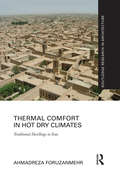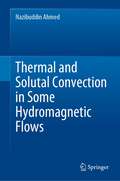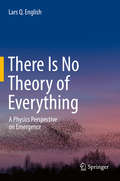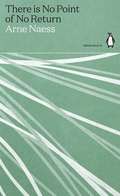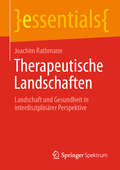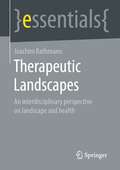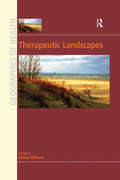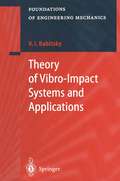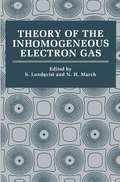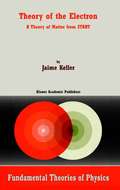- Table View
- List View
Thermal Conductivity: Theory, Properties, and Applications (Physics of Solids and Liquids)
by Terry M. TrittIt has been almost thirty years since the publication of a book that is entirely dedicated to the theory, description, characterization and measurement of the thermal conductivity of solids. The recent discovery of new materials which possess more complex crystal structures and thus more complicated phonon scattering mechanisms have brought innovative challenges to the theory and experimental understanding of these new materials. With the development of new and novel solid materials and new measurement techniques, this book will serve as a current and extensive resource to the next generation researchers in the field of thermal conductivity. This book is a valuable resource for research groups and special topics courses (8-10 students), for 1st or 2nd year graduate level courses in Thermal Properties of Solids, special topics courses in Thermal Conductivity, Superconductors and Magnetic Materials, and to researchers in Thermoelectrics, Thermal Barrier Materials and Solid State Physics.
Thermal Comfort in Hot Dry Climates: Traditional Dwellings in Iran (Routledge Research in Architecture)
by Ahmadreza ForuzanmehrWith increases in global temperatures, the risk of overheating is expected to rise around the world. This results in a much higher dependency upon energy-intensive cooling systems and air-conditioners to provide thermal comfort, but how sustainable is this in a world where problems with the production of electricity are predicted? Vernacular houses in hot and dry central Iran have been adapted to the climate through passive cooling techniques, and this book provides a valuable assessment of the thermal performance of such housing. Shedding new light on the ability of traditional housing forms to provide thermal comfort, Thermal Comfort in Hot Dry Climates identifies the main cooling systems and methods in traditional houses in central Iran, and examines how architectural elements such as central courtyards, distinct seasonal rooms, loggias, basements and wind-catchers can contribute to the provision of thermal comfort in vernacular houses.
Thermal Comfort in Hot Dry Climates: Traditional Dwellings in Iran (Routledge Research in Architecture)
by Ahmadreza ForuzanmehrWith increases in global temperatures, the risk of overheating is expected to rise around the world. This results in a much higher dependency upon energy-intensive cooling systems and air-conditioners to provide thermal comfort, but how sustainable is this in a world where problems with the production of electricity are predicted? Vernacular houses in hot and dry central Iran have been adapted to the climate through passive cooling techniques, and this book provides a valuable assessment of the thermal performance of such housing. Shedding new light on the ability of traditional housing forms to provide thermal comfort, Thermal Comfort in Hot Dry Climates identifies the main cooling systems and methods in traditional houses in central Iran, and examines how architectural elements such as central courtyards, distinct seasonal rooms, loggias, basements and wind-catchers can contribute to the provision of thermal comfort in vernacular houses.
Thermal and Statistical Physics: Concepts and Applications
by Sandeep SharmaThis textbook presents the fundamental concepts and theories in thermal physics and elementary statistical mechanics in a very simple, systematic and comprehensive way. This book is written in a way that it presents the topics in a holistic manner with end-of-chapter exercises and examples where concepts are supported by numerous solved examples and multiple-choice questions to aid self-learning. The textbook also contains illustrated diagrams for better understanding of the concepts. The book will benefit students who are taking introductory courses in thermal physics, thermodynamics and statistical mechanics.
Thermal and Solutal Convection in Some Hydromagnetic Flows
by Nazibuddin AhmedThis book presents a theoretical analysis of several problems in thermal and solutal convections in magneto-hydrodynamic (MHD) flows. It provides a systemic discussion on the development of fluid dynamics, continuum hypothesis, Newton’s law of viscosity, heat transfer, mass transfer, thermal diffusion, diffusion-thermo-MHD, gray and non-gray gases, Fourier’s law of conduction, and Fick’s law of diffusion in such a way that readers with little knowledge in physics will find it easier to understand the contents. Some physical principles, such as those governing fluid motion, fluid temperature, and fluid concentration, are presented in vector form, allowing the corresponding form to be derived in any orthogonal curvilinear coordinate system. Laplace transform technique in closed form is used to obtain exact solutions to unsteady one-dimensional flow problems, an implicit finite difference method of Crank–Nicholson type is used to solve unsteady two-dimensional flow problems, and an asymptotic series expansion method is used to solve the governing equations of the steady three-dimensional flow problem analytically. Flow and transport phenomena are thoroughly treated in each chapter separately. This book emphasizes the influence of an induced magnetic field. The outcomes of the works are graphically depicted so that readers can gain a tangible understanding of the problems. It also includes a list of inverse Laplace transforms (ILTs) for several specific functions, some of which are not found in the existing literature. The ILTs of special functions are given in brief form and can further be utilized as standard formulae in finding those as special cases. Some new special functions are introduced in the book, along with appropriate definitions. As a result, the formulations for velocity, temperature, concentration, skin friction, Nusselt number, and Sherwood number have been appeared in brief and convenient forms that are uncommon in other literature. This book addresses numerous areas of contemporary magneto-fluid dynamics research that have major implications in engineering. It is primarily intended for researchers working in the field of heat and mass transfer in hydromagnetic flows.
Thermal and Mineral Waters: Origin, Properties and Applications (Environmental Earth Sciences)
by Werner Balderer Adam Porowski Hussein Idris James W. LaMoreauxThis is a compilation of manuscripts on mineral and thermal waters of different areas of the world. This special volume is devoted to the 41st Meeting of the Commission on Mineral and Thermal Waters of International Association of Hydrogeologists (IAH-CMTW) held in Cairo, Egypt, in October 2009. The presentations collected and presented in this volume show the variety of aspects of mineral and thermal waters occurrence and utilization in different countries of the world with a special focus on Egypt, Iran, Ukraine, Poland, Russia and Australia.
There Is No Theory of Everything: A Physics Perspective on Emergence
by Lars Q. EnglishThe main purpose of this book is to introduce a broader audience to emergence by illustrating how discoveries in the physical sciences have informed the ways we think about it. In a nutshell, emergence asserts that non-reductive behavior arises at higher levels of organization and complexity. As physicist Philip Anderson put it, “more is different.” Along the text's conversational tour through the terrain of quantum physics, phase transitions, nonlinear and statistical physics, networks and complexity, the author highlights the various philosophical nuances that arise in encounters with emergence. The final part of the book zooms out to reflect on some larger lessons that emergence affords us. One of those larger lessons is the realization that the great diversity of theories and models, and the great variety of independent explanatory frameworks, will always be with us in the sciences and beyond. There is no “Theory of Everything” just around the corner waiting to be discovered.One of the main benefits of this book is that it will make a number of exciting scientific concepts that are not normally covered at this level accessible to a broader audience. The overall presentation, including the use of examples, analogies, metaphors, and biographical interludes, is geared for the educated non-specialist.
There is No Point of No Return (Green Ideas)
by Arne NæssIn twenty short books, Penguin brings you the classics of the environmental movement.Emphasizing joy in the world, human cooperation and the value of all living things, this selection of Arne Naess' philosophical writings is filled with wit, learning and an intense connection with nature.Over the past 75 years, a new canon has emerged. As life on Earth has become irrevocably altered by humans, visionary thinkers around the world have raised their voices to defend the planet, and affirm our place at the heart of its restoration. Their words have endured through the decades, becoming the classics of a movement. Together, these books show the richness of environmental thought, and point the way to a fairer, saner, greener world.
Therapeutische Landschaften: Landschaft und Gesundheit in interdisziplinärer Perspektive (essentials)
by Joachim RathmannJoachim Rathmann stellt die interdisziplinären Bezüge von Landschaften und Gesundheit dar. Die Natur ist als elementare Gesundheitsressource zu betrachten, denn Bewegung in naturnaher Umgebung hat nachweislich positive Einflüsse auf die menschliche Gesundheit und wird im Konzept der „Therapeutischen Landschaften“ vielfältig zusammengefasst. Naturräume bieten vor allem einer älter werdenden Gesellschaft eine wichtige, auch ökonomisch messbare Ressource für die Stärkung von Gesundheit. Der Autor bereitet natur-, sozial,- und geisteswissenschaftliche Untersuchungen für eine breit gefächerte Leserschaft verständlich, anschaulich und übersichtlich auf. Gleichzeitig gibt er Anregungen für einen bewussten Umgang mit der sensiblen Ressource Landschaft und zu einer regelmäßigen Naturbeobachtung.
Therapeutic Landscapes: An Interdisciplinary Perspective on Landscape and Health (essentials)
by Joachim RathmannJoachim Rathmann presents the interdisciplinary relationships between landscapes and health. Nature is to be regarded as an elementary health resource, because movement in near-natural surroundings has demonstrably positive influences on human health and is summarized in many ways in the concept of "therapeutic landscapes". Natural areas offer an important resource for strengthening health, especially to an aging society, which can also be measured economically. The author presents natural science, social science, and humanities research in a clear, understandable, and concise manner for a broad readership. At the same time he gives suggestions for a conscious handling of the sensitive resource landscape and for a regular observation of nature. This springer essential is a translation of the original German 1st edition essentials,Therapeutic landscapes by Joachim Rathmann, published by Springer Fachmedien Wiesbaden GmbH, part of Springer Nature in 2020.The translation was done with the help of artificial intelligence (machine translation by the service DeepL.com). A subsequent human revision was done primarily in terms of content, so that the book will read stylistically differently from a conventional translation. Springer Nature works continuously to further the development of tools for the production of books and on the related technologies to support the authors.
Therapeutic Landscapes (Geographies of Health Series)
by Allison WilliamsThe therapeutic landscape concept, first introduced early in the 1990s, has been widely employed in health/medical geography and gaining momentum in various health-related disciplines. This is the first book published in several years, and provides an introduction to the concept and its applications. Written by health/medical geographers and anthropologists, it addresses contemporary applications in the natural and built environments; for special populations, such as substance abusers; and in health care sites, a new and evolving area - and provides an array of critiques or contestations of the concept and its various applications. The conclusion of the work provides a critical evaluation of the development and progress of the concept to date, signposting the likely avenues for future investigation.
Therapeutic Landscapes (Geographies of Health Series)
by Allison WilliamsThe therapeutic landscape concept, first introduced early in the 1990s, has been widely employed in health/medical geography and gaining momentum in various health-related disciplines. This is the first book published in several years, and provides an introduction to the concept and its applications. Written by health/medical geographers and anthropologists, it addresses contemporary applications in the natural and built environments; for special populations, such as substance abusers; and in health care sites, a new and evolving area - and provides an array of critiques or contestations of the concept and its various applications. The conclusion of the work provides a critical evaluation of the development and progress of the concept to date, signposting the likely avenues for future investigation.
Theory of Vibro-Impact Systems and Applications (Foundations of Engineering Mechanics)
by Vladimir I. Babitsky- Models of vibro-impact systems are widely used in machine dynamics, vibration engineering, and structural mechanics. - Only monograph on this subject in English language. - Systematically presents the theory of vibro-impact systems by analysis of typical engineering applications. - Experimental data and computer simulations are presented. - Targeted to engineers and researchers in design and investigation of mechanical systems as well as to lecturers and advanced students.
The Theory of Turbulence: Subrahmanyan Chandrasekhar's 1954 Lectures (Lecture Notes in Physics #810)
by Edward A. SpiegelIn January 1937, Nobel laureate in Physics Subrahmanyan Chandrasekhar was recruited to the University of Chicago. He was to remain there for his entire career, becoming Morton D. Hull Distinguished Service Professor of Theoretical Astrophysics in 1952 and attaining emeritus status in 1985. This is where his then student Ed Spiegel met him during the summer of 1954, attended his lectures on turbulence and jotted down the notes in hand. His lectures had a twofold purpose: they not only provided a very elementary introduction to some aspects of the subject for novices, they also allowed Chandra to organize his thoughts in preparation to formulating his attack on the statistical problem of homogeneous turbulence. After each lecture Ed Spiegel transcribed the notes and filled in the details of the derivations that Chandrasekhar had not included, trying to preserve the spirit of his presentation and even adding some of his side remarks. The lectures were rather impromptu and the notes as presented here are as they were set down originally in 1954. Now they are being made generally available for Chandrasekhar’s centennial.
Theory of Thermodynamic Measurements of Quantum Systems Far from Equilibrium (Springer Theses)
by Abhay ShastryThis thesis presents several related advances in the field of nonequilibrium quantum thermodynamics. The central result is an ingenious proof that the local temperature and voltage measurement in a nonequilibrium system of fermions exists and is unique, placing the concept of local temperature on a rigorous mathematical footing for the first time. As an intermediate step, a proof of the positivity of the Onsager matrix of linear response theory is given -- a statement of the second law of thermodynamics that had lacked an independent proof for 85 years. A new experimental method to measure the local temperature of an electron system using purely electrical techniques is also proposed, which could enable improvements to the spatial resolution of thermometry by several orders of magnitude. Finally, a new mathematically-exact definition for the local entropy of a quantum system in a nonequilibrium steady state is derived. Several different measures of the local entropy are discussed, relating to the thermodynamics of processes that a local observer with varying degrees of information about the microstates of the system could carry out, and it is shown that they satisfy a hierarchy of inequalities. Proofs of the third law of thermodynamics for generic open quantum systems are presented, taking into account the entropic contribution due to localized states. Appropriately normalized (per-state) local entropies are defined and are used to quantify the departure from local equilibrium.
The Theory of the Top. Volume IV: Technical Applications of the Theory of the Top
by Felix Klein Arnold SommerfeldThe Theory of the Top was originally presented by Felix Klein as an 1895 lecture at Göttingen University that was broadened in scope and clarified as a result of collaboration with Arnold Sommerfeld. The Theory of the Top: Volume IV. Technical Applications of the Theory of the Top is the fourth and final installment in a series of self-contained English translations that provide insights into kinetic theory and kinematics.
The Theory of the Top Volume III: Perturbations. Astronomical and Geophysical Applications
by Felix Klein Arnold SommerfeldThe Theory of the Top was originally presented by Felix Klein as an 1895 lecture at Göttingen University that was broadened in scope and clarified as a result of collaboration with Arnold Sommerfeld. The Theory of the Top: Volume III. Perturbations: Astronomical and Geophysical Applications is the third installment in a series of four self-contained English translations that provide insights into kinetic theory and kinematics.
The Theory of the Top. Volume II: Development of the Theory in the Case of the Heavy Symmetric Top
by Felix Klein Arnold SommerfeldThe Theory of the Top. Volume II. Development of the Theory in the Case of the Heavy Symmetric Top is the second in a series of four self-contained English translations of the classic and definitive treatment of rigid body motion. Graduate students and researchers interested in theoretical and applied mechanics will find this a thorough and insightful account. Other works in this series include Volume I. Introduction to the Kinematics and Kinetics of the Top, Volume III. Perturbations. Astronomical and Geophysical Applications, and Volume IV. Technical Applications of the Theory of the Top.
The Theory of the Top. Volume I: Introduction to the Kinematics and Kinetics of the Top
by Felix Klein Arnold SommerfeldThe lecture series on the Theory of the Top was originally given as a dedication to Göttingen University by Felix Klein in 1895, but has since found broader appeal. The Theory of the Top: Volume I. Introduction to the Kinematics and Kinetics of the Top is the first of a series of four self-contained English translations that provide insights into kinetic theory and kinematics.
Theory of the Nuclear Magnetic 1/T1 Relaxation Rate in Conventional and Unconventional Magnets (Springer Theses)
by Andrew SmeraldOne of the best ways to "lift the lid" on what is happening inside a given material is to study it using nuclear magnetic resonance (NMR). Of particular interest are NMR 1/T1 relaxation rates, which measure how fast energy stored in magnetic nuclei is transferred to surrounding electrons. This thesis develops a detailed, quantitative theory of NMR 1/T1 relaxation rates, and shows for the first time how they could be used to measure the speed at which energy travels in a wide range of magnetic materials. This theory is used to make predictions for"Quantum Spin Nematics", an exotic form of quantum order analogous to a liquid crystal. In order to do so, it is first necessary to unravel how spin nematics transport energy. This thesis proposes a new way to do this, based on the description of quarks in high-energy physics. Experiments to test the ideas presented are now underway in laboratories across the world.
Theory of the Inhomogeneous Electron Gas (Physics of Solids and Liquids)
by Stig Lundqvist Norman H. MarchThe theory of the inhomogeneous electron gas had its origin in the Thomas Fermi statistical theory, which is discussed in the first chapter of this book. This already leads to significant physical results for the binding energies of atomic ions, though because it leaves out shell structure the results of such a theory cannot reflect the richness of the Periodic Table. Therefore, for a long time, the earlier method proposed by Hartree, in which each electron is assigned its own personal wave function and energy, dominated atomic theory. The extension of the Hartree theory by Fock, to include exchange, had its parallel in the density description when Dirac showed how to incorporate exchange in the Thomas-Fermi theory. Considerably later, in 1951, Slater, in an important paper, showed how a result similar to but not identical with that of Dirac followed as a simplification of the Hartree-Fock method. It was Gombas and other workers who recognized that one could also incorporate electron correlation consistently into the Thomas-Fermi-Dirac theory by using uniform electron gas relations locally, and progress had been made along all these avenues by the 1950s.
Theory of the Electron: A Theory of Matter from START (Fundamental Theories of Physics #115)
by J. KellerIn the first century after its discovery, the electron has come to be a fundamental element in the analysis of physical aspects of nature. This book is devoted to the construction of a deductive theory of the electron, starting from first principles and using a simple mathematical tool, geometric analysis. Its purpose is to present a comprehensive theory of the electron to the point where a connection can be made with the main approaches to the study of the electron in physics. The introduction describes the methodology. Chapter 2 presents the concept of space-time-action relativity theory and in chapter 3 the mathematical structures describing action are analyzed. Chapters 4, 5, and 6 deal with the theory of the electron in a series of aspects where the geometrical analysis is more relevant. Finally in chapter 7 the form of geometrical analysis used in the book is presented to elucidate the broad range of topics which are covered and the range of mathematical structures which are implicitly or explicitly included. The book is directed to two different audiences of graduate students and research scientists: primarily to theoretical physicists in the field of electron physics as well as those in the more general field of quantum mechanics, elementary particle physics, and general relativity; secondly, to mathematicians in the field of geometric analysis.
Theory of Stochastic Differential Equations with Jumps and Applications: Mathematical and Analytical Techniques with Applications to Engineering (Mathematical and Analytical Techniques with Applications to Engineering)
by Rong SITUStochastic differential equations (SDEs) are a powerful tool in science, mathematics, economics and finance. This book will help the reader to master the basic theory and learn some applications of SDEs. In particular, the reader will be provided with the backward SDE technique for use in research when considering financial problems in the market, and with the reflecting SDE technique to enable study of optimal stochastic population control problems. These two techniques are powerful and efficient, and can also be applied to research in many other problems in nature, science and elsewhere.
Theory of Stellar Atmospheres: An Introduction to Astrophysical Non-equilibrium Quantitative Spectroscopic Analysis
by Ivan Hubeny Dimitri MihalasThis book provides an in-depth and self-contained treatment of the latest advances achieved in quantitative spectroscopic analyses of the observable outer layers of stars and similar objects. Written by two leading researchers in the field, it presents a comprehensive account of both the physical foundations and numerical methods of such analyses. The book is ideal for astronomers who want to acquire deeper insight into the physical foundations of the theory of stellar atmospheres, or who want to learn about modern computational techniques for treating radiative transfer in non-equilibrium situations. It can also serve as a rigorous yet accessible introduction to the discipline for graduate students.Provides a comprehensive, up-to-date account of the fieldCovers computational methods as well as the underlying physicsServes as an ideal reference book for researchers and a rigorous yet accessible textbook for graduate studentsAn online illustration package is available to professors at press.princeton.edu
The Theory of Sprays and Finsler Spaces with Applications in Physics and Biology (Fundamental Theories of Physics #58)
by P.L. Antonelli Roman S. Ingarden M. MatsumotoThe present book has been written by two mathematicians and one physicist: a pure mathematician specializing in Finsler geometry (Makoto Matsumoto), one working in mathematical biology (Peter Antonelli), and a mathematical physicist specializing in information thermodynamics (Roman Ingarden). The main purpose of this book is to present the principles and methods of sprays (path spaces) and Finsler spaces together with examples of applications to physical and life sciences. It is our aim to write an introductory book on Finsler geometry and its applications at a fairly advanced level. It is intended especially for graduate students in pure mathemat ics, science and applied mathematics, but should be also of interest to those pure "Finslerists" who would like to see their subject applied. After more than 70 years of relatively slow development Finsler geometry is now a modern subject with a large body of theorems and techniques and has math ematical content comparable to any field of modern differential geometry. The time has come to say this in full voice, against those who have thought Finsler geometry, because of its computational complexity, is only of marginal interest and with prac tically no interesting applications. Contrary to these outdated fossilized opinions, we believe "the world is Finslerian" in a true sense and we will try to show this in our application in thermodynamics, optics, ecology, evolution and developmental biology. On the other hand, while the complexity of the subject has not disappeared, the modern bundle theoretic approach has increased greatly its understandability.

